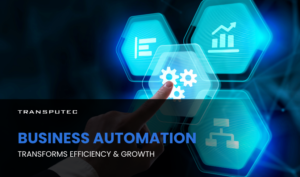Written by KRITIKA SINHA | MARKETING
The monthly reports don’t match. Customer data is incomplete. Inventory records are months out of sync. Your teams waste hours cleaning spreadsheets, fixing errors, and manually reconciling information across systems that were never designed to talk to each other. Meanwhile, business decisions are delayed or made with outdated data.
This is data chaos and it’s a hidden cost that affects every part of your operation.
AI for Business isn’t about chasing trends. It’s about fixing real, structural problems caused by poor data visibility and unreliable processes. In this blog, we’ll explain what data chaos looks like in practical terms, how AI solves these challenges, and how Transputec delivers working solutions without major disruption. You’ll learn how to identify operational risks caused by bad data, what AI systems do behind the scenes, and where to start.
What Is Data Chaos, and Why Does It Matter for Businesses?
Data chaos refers to fragmented, inconsistent, or duplicated data spread across multiple systems. It can stem from legacy platforms, manual entry, poor system integrations, or lack of governance. For mid-sized to enterprise organisations, the problem usually grows unnoticed—until it blocks critical operations.
The impact of data chaos includes:
- Delayed decision-making due to unclear reports
- Cost overruns from inventory or procurement errors
- Poor customer service from mismatched information
- Regulatory risk from inaccurate or non-compliant records
According to IBM, bad data costs businesses globally more than $3 trillion each year. For operations leaders, this isn’t just an IT issue—it’s a risk to efficiency, compliance, and growth.
Where Data Chaos Happens Most Often
Before applying AI for Business, it helps to identify where the biggest risks lie. These are the departments where data chaos is most common:
1. Finance and Procurement
Finance teams often deal with multiple sources of data—ERP systems, bank statements, supplier portals, and Excel files. Without consistent integration, figures don’t match, payment schedules slip, and spend tracking becomes unreliable. Procurement teams face similar problems, such as conflicting supplier records or mismatched product codes between catalogues and invoices.
Common issues:
- Duplicate supplier entries
- Inconsistent tax rates or currency conversions
- Late payments due to missing or incorrect data
2. Sales and Customer Support
Customer data may be scattered across CRM platforms, order management systems, email inboxes, and support tickets. When these sources don’t align, sales reps may contact leads with the wrong information, or support teams may overlook previous complaints or preferences.
Common issues:
- Duplicate or outdated customer records
- Incomplete sales histories
- Poor handoffs between sales and support
3. Operations and Logistics
Warehousing, inventory control, and delivery scheduling depend on accurate, real-time data. However, operations often use separate tools that don’t share updates automatically. As a result, inventory counts may be inaccurate, shipments delayed, or job statuses misreported.
Common issues:
- Disconnected inventory and order management systems
- Manual logging of job completion or asset movements
- Delayed detection of supply chain disruptions
4. Human Resources and Compliance
HR teams manage sensitive employee data that must remain consistent across platforms like payroll, benefits, learning management, and onboarding systems. Errors in one system can lead to missed benefits, incorrect pay, or non-compliance with labour laws.
Common issues:
- Misaligned employment records across tools
- Out-of-date compliance training records
- Manual handling of onboarding documents
Ready to Explore AI for Your Business?
Connect with us today for our free consultation!
How AI for Business Solves Data Chaos?
AI for Business addresses data chaos by automating the detection, correction, and standardisation of data across systems. Unlike traditional scripts or one-time migrations, AI adapts to ongoing changes in your data patterns and fixes issues continuously.
Here’s how it works at a functional level:
1. Data Cleansing and Normalisation
AI uses natural language processing and pattern recognition to identify duplicate entries, mismatches, or incomplete records. It then standardises data into a uniform format.
Example:
If one system records customer country as “U.K.” and another as “United Kingdom,” AI detects the pattern and unifies both under a single label.
2. Automated Reconciliation
AI continuously checks for inconsistencies across databases or software. It flags entries that don’t align and, where safe, automatically updates or suggests corrections.
Example:
In procurement, AI can identify when an invoice doesn’t match a purchase order and notify finance before the payment is processed.
3. Predictive Alerts
AI learns from past data behaviour and can predict when something is likely to go wrong. This allows teams to correct small issues before they become operational disruptions.
Example:
In logistics, AI might detect that a certain supplier consistently delays delivery and recommend stock adjustments to avoid shortages.
4. Workflow Integration
AI connects to your tools via APIs and automates repetitive tasks—such as updating multiple records, reconciling systems, or enriching data from third-party sources.
Example:
AI can auto-fill missing contact fields using public data sources or infer job titles based on email domains.
Key Benefits of Using AI for Business in Operations
Adopting AI for Business to handle data issues brings measurable advantages beyond just saving time. It transforms how your organisation works, allowing for smarter decision-making, improved customer service, and increased agility.
1. Improved Accuracy Across Systems
Clean, consistent data leads to fewer mistakes and less rework. Whether you’re calculating revenue, forecasting demand, or reviewing compliance, accuracy is critical.
2. Faster Decision-Making
When decision-makers have access to real-time, reliable information, they don’t need to wait for monthly reports or manual reconciliation. This speeds up responses to changes in demand, costs, or customer behaviour.
3. Reduced Operational Costs
By automating routine tasks like matching records, generating reports, or updating systems, AI reduces the need for manual labour and cuts down on costly errors.
4. Better Customer Experience
When customer data is reliable and accessible across departments, your staff can respond faster, offer more relevant help, and build stronger relationships.
5. Increased Compliance and Audit Readiness
AI ensures that records are complete, traceable, and up to date. This makes regulatory compliance easier and faster to audit, reducing legal risk and penalties.
6. Scalable Processes
As your business grows, so does the volume of data. AI allows you to scale operations without proportionally increasing headcount or IT overhead.
How Transputec’s AI for Business Helps?
Transputec has spent decades working with real-world organisations dealing with fragmented systems and unreliable data. Their approach to AI for Business is hands-on, outcome-focused, and tailored for operational decision-makers.
What Transputec Does Differently:
System Audits and Data Mapping
Transputec starts by mapping your current systems, showing exactly where breakdowns occur and what the data quality looks like.Custom AI Models Built on Your Data
Off-the-shelf AI doesn’t work for every business. Transputec trains models based on your processes, terms, and objectives.Minimal Disruption
AI is layered onto your existing systems rather than replacing them. This avoids downtime or expensive re-platforming.Ongoing Monitoring and Alerts
After implementation, Transputec sets up dashboards and alerts to keep your data clean and operations on track.
Conclusion
Data chaos is one of the most costly and persistent issues businesses face today. It delays decisions, undermines performance, and puts compliance at risk. AI for Business offers a practical, proven way to address these problems—by cleaning, connecting, and managing your data in real time.
Throughout this blog, we’ve shown what causes data chaos, where it shows up most, and how Transputec helps businesses fix it without overhauling their systems. By applying AI intelligently, businesses can stop putting out data fires and start making better decisions with confidence.
Contact us to connect with an AI expert and get started with Transputec.

Ready to Transform Your Business with AI?
Connect with an expert and get started on the next generation of IT support.
FAQs
1. What is AI for Business and how is it different from general AI?
AI for Business refers to artificial intelligence applications focused on improving operational processes. Unlike consumer AI or general research tools, it’s designed to solve real business problems like data cleansing, automation, and error detection in enterprise environments.
2. How does Transputec apply AI for Business without disrupting our current systems?
Transputec integrates AI as a layer on top of your existing systems. This avoids the need for full platform replacements. Their team configures connectors and applies machine learning models tailored to your data structures and operational needs.
3. What kind of data issues can Transputec’s AI solve?
Transputec’s AI can fix data duplication, inconsistent formatting, mismatched records, missing entries, and incorrect relationships between systems (e.g., CRM to ERP). It can also predict potential data failures before they affect operations.
4. Is AI for Business only useful for large companies?
No. While larger companies often see the biggest gains, mid-sized businesses benefit significantly—especially those struggling with fragmented tools or legacy systems. Transputec works with organisations of all sizes to deliver practical AI solutions.
5. How long does it take to see results with Transputec’s AI implementation?
Most clients see measurable improvements within 60–90 days of starting a project. Transputec prioritises quick wins and designs implementation plans that avoid lengthy timelines or major disruptions.






